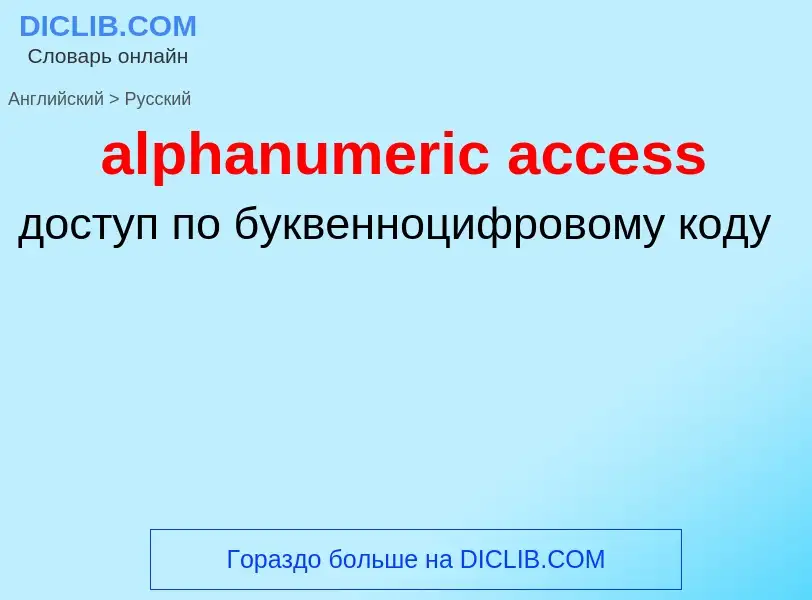Перевод и анализ слов искусственным интеллектом ChatGPT
На этой странице Вы можете получить подробный анализ слова или словосочетания, произведенный с помощью лучшей на сегодняшний день технологии искусственного интеллекта:
- как употребляется слово
- частота употребления
- используется оно чаще в устной или письменной речи
- варианты перевода слова
- примеры употребления (несколько фраз с переводом)
- этимология
alphanumeric access - перевод на русский
общая лексика
файл базы данных в СУБД Access
общая лексика
прямой [произвольный] доступ
способ организации доступа к устройству памяти, при котором для чтения/записи произвольного блока данных не требуется последовательный просмотр блоков, начиная с самого первого, например ОЗУ, диски
произвольный порядок обращения
синоним
общая лексика
коллективный доступ
Определение
Википедия
Mathematical Alphanumeric Symbols is a Unicode block comprising styled forms of Latin and Greek letters and decimal digits that enable mathematicians to denote different notions with different letter styles. The letters in various fonts often have specific, fixed meanings in particular areas of mathematics. By providing uniformity over numerous mathematical articles and books, these conventions help to read mathematical formulas. These also may be used to differentiate between concepts that share a letter in a single problem.
Unicode now includes many such symbols (in the range U+1D400–U+1D7FF). The rationale behind this is that it enables design and usage of special mathematical characters (fonts) that include all necessary properties to differentiate from other alphanumerics, e.g. in mathematics an italic "𝐴" can have a different meaning from a roman letter "A". Unicode originally included a limited set of such letter forms in its Letterlike Symbols block before completing the set of Latin and Greek letter forms in this block beginning in version 3.1.
Unicode expressly recommends that these characters not be used in general text as a substitute for presentational markup; the letters are specifically designed to be semantically different from each other. Unicode does not include a set of normal serif letters in the set. Still they have found some usage on social media, for example by people who want a stylized user name, and in email spam, in an attempt to bypass filters.
All these letter shapes may be manipulated with MathML's attribute mathvariant.
The introduction date of some of the more commonly used symbols can be found in the Table of mathematical symbols by introduction date.


![''Kraftfahrstrasse'' passage of [[Bundesautobahn 60]] near [[Prüm]]–[[Bleialf]] ''Kraftfahrstrasse'' passage of [[Bundesautobahn 60]] near [[Prüm]]–[[Bleialf]]](https://commons.wikimedia.org/wiki/Special:FilePath/1031482 A60 Prüm-Bleialf.jpg?width=200)

![Aptos]] area.<br>(Map source: [[OpenStreetMap]]) Aptos]] area.<br>(Map source: [[OpenStreetMap]])](https://commons.wikimedia.org/wiki/Special:FilePath/Limited access road CA1.png?width=200)
![County Route G4]] (Montague Expressway), an American expressway under the MUTCD definition County Route G4]] (Montague Expressway), an American expressway under the MUTCD definition](https://commons.wikimedia.org/wiki/Special:FilePath/Montague Expressway.jpg?width=200)

![Enshi Prefecture]], [[Hubei]], [[China]]. Enshi Prefecture]], [[Hubei]], [[China]].](https://commons.wikimedia.org/wiki/Special:FilePath/SiduheBridge.jpg?width=200)
![Superstrada (SS131) [[Sassari]] - [[Porto Torres]], in [[Sardinia]]. Superstrada (SS131) [[Sassari]] - [[Porto Torres]], in [[Sardinia]].](https://commons.wikimedia.org/wiki/Special:FilePath/Ss131camionale ss-portotorres9539286.jpg?width=200)


